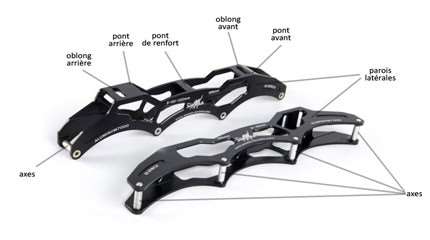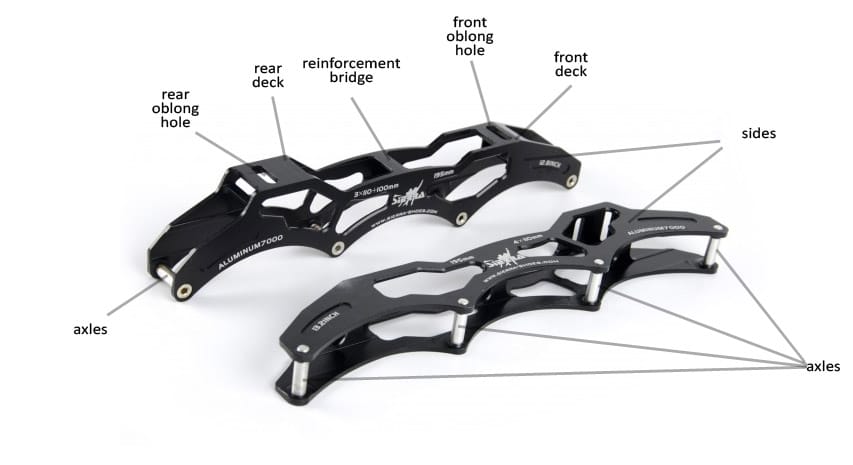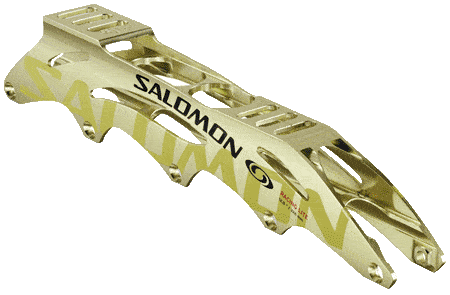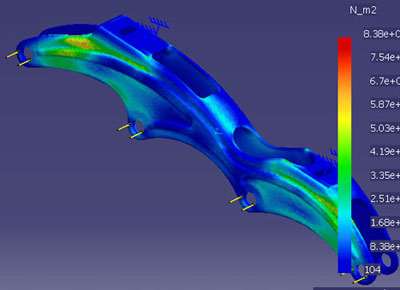Anatomy of a skate frame
The frame ensures the link between the boot and the wheels. Its technical characteristics (rigidity, length…) may considerably vary according to the considered practice.
Par alfathor

Description and composition
 The frame is the part of the skate undercarriage on which the boot is fixed. It gathers the wheels. A frame is made of different parts:
The frame is the part of the skate undercarriage on which the boot is fixed. It gathers the wheels. A frame is made of different parts:
A front and a rear bridge on which are respectively fixed the tip and the heel of the skate boot. Slip the screws into the oblong holes of the frame and fasten them. On many frames, the oblong hole is wide enough to enable lateral adjustments. The distance between the front and rear oblong holes is measured in millimeters. The most common spacings are 165 mm (for 90 mm wheel or less) and 195 mm (for wheels over 90 mm).
 The oblong holes may be placed crosswise or lengthwise, so that you can adjust the frame either sidelong or lengthways. Then you can set up your skate frames according to your use and practice.
The oblong holes may be placed crosswise or lengthwise, so that you can adjust the frame either sidelong or lengthways. Then you can set up your skate frames according to your use and practice.
In order to rigidify the frame, reinforcement bridges are sometimes added in-between the sides. The sides of the frame gather the axles around which the wheels turn. The frame is the part which supports the boot and to which the wheels are fixed. It may be made of different materials:
- Polymeres: polyurethane, nylon (low end models)
- Composite: often nylon and glass or carbon fiber
- Metal: essentially aluminum, but also magnesium or titanium, even a mix of these materials.
The different types of frames
There are different types of frames according to the concerned disciplines. The classification is made by:
- nature of the materials
- type
- length of the frame in millimeters
Frames can support 2 to 5 wheels. The chemical composition of the frame, its mode of production, of fixing vary.
There are different types of frames:
- cast in one piece
- in several parts
Differents types of fixing:
- riveted
- screwed
- molded in one piece
- integrated to the boot (very rare)
A plastic frame will offer a better comfort with use as its flexibility absorbs vibrations and shocks. On the other hand, it is less reactive and the transmission of the stride energy is less efficient.
Metal frames are more rigid and also more performant. They have a better energy rendering. On the other hand, they also relay all the vibrations and imperfections of the ground. They are less comfortable.
Some models include vibration absorbers, but one may wonder how efficient they actually are.
 Composite frames (like carbon for example) are lighter and more reactive. They may be more rigid than metal, it all depends on their design. Yet, they ‘explode’ rather than bend in case of a violent shock. No risk however with intensive use, they have a great resistance to effort.
Composite frames (like carbon for example) are lighter and more reactive. They may be more rigid than metal, it all depends on their design. Yet, they ‘explode’ rather than bend in case of a violent shock. No risk however with intensive use, they have a great resistance to effort.
The length of the frame
The length of the frame should be chosen according to your main discipline. The shorter the frame, the handier it is. A short frame is very good for hockey, slalom, aggressive and free skating.
The longer the frame, the less handy it is. On the other hand, it is more stable and relays better the energy of your stride. That type of frame is rather used for long distance skating or speed skating.
Rockered frames
It is a specific adjustment of the wheels in height or in length. That process is only available on some specific models. Most of the time, the aim of those modifications is to improve the general handiness of the skate, for disciplines such as hockey or slalom. When the number of wheels in contact with the ground changes, the handiness is modified.
Tip
When you change your wheels, check the maximum diameter supported by your frame as there are important differences according to the type of practice, the range of your skates and their brand.
Useful links
Extracting an axle or a screw stuck in a frame
The maintenance of your skate frame
Well choosing your speed skating frames
Translation: Chloé Seyres
Photo: Salomon & EOskates
